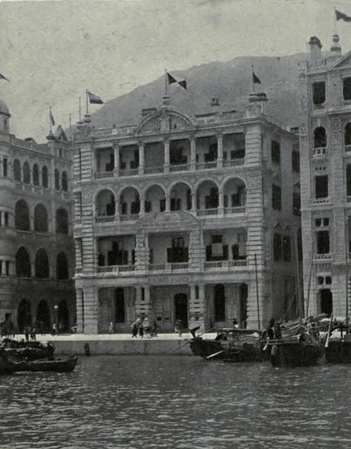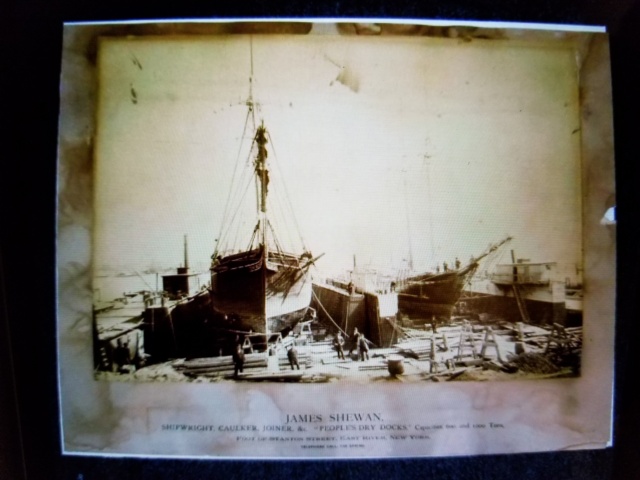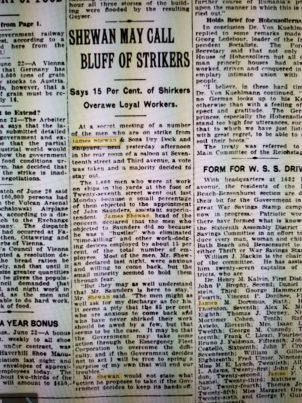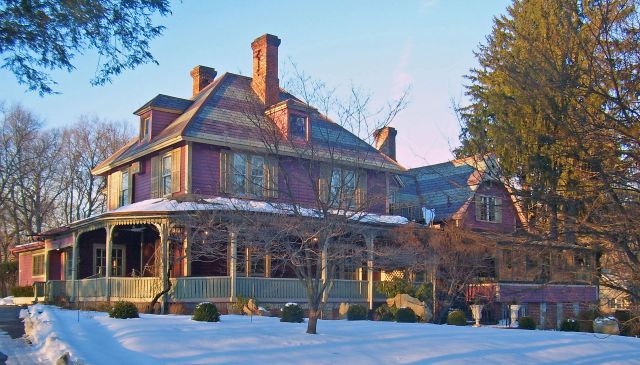
This is James Shewan, a pretty distinguished looking fellow if you ask me
By Cecil Hoge
On my mother’s side I come from a sea-faring family. I have already written something about my mother’s father, Edwin Shewan, in my blog story entitled “Grandpa Gets Busted“. In that story I told about some of my grandfather’s escapades on his yacht during Prohibition. He was a pretty colorful gentleman. I think it is only fair to write some things about his father, my great grandfather. His name was James Shewan.
The picture of him above comes from a book entitled, “Scots and Scots’ Descendants in America, Volume 1”. Now, I never met my great grandfather. He died in 1914 which is a pretty good reason why. What I know about him comes from my wife’s explorations of Ancestry.com, the book cited above, some newspaper accounts and some pictures that I or my wife have discovered on the internet. There are no living relatives who knew him personally who I could speak to or who knew about him to tell me more, so this account of my great grandfather will no doubt miss some important details of his life.
Because my wife has been researching Ancestry.com and other websites for the last 20 years, she was able to find passport copies, birth certificates, newspapers accounts of the Shewan family going as far back as the 1750s. This was very helpful in providing me unknown details of the Shewan family. It also provided me with pictures and information about family members that I never knew I had. And in particular she was able to find both book and newspaper accounts of my illustrious great grandfather.
My father did tell me that James Shewan was the man who made the real fortune for my grandfather, Edwin Shewan. I do not remember my mother telling me anything about my great grandfather, but since she was born in 1919, she also never met James Shewan. From his appearance in the above photo I would think he was a very upright, religious, hard-working man.
The description of my great grandfather as told in “Scots and Scots’s Descendants” comes a few pages after the description of Theodore Roosevelt, who apparently was another notable Scot. Other notable Scots written about in that book are Lord & Lady Aberdeen and Alexander Graham Bell, so he was among some pretty famous folks.

This is a very old picture of one of the dry docks owned by James Shewan
James Shewan was the founder of the largest dry dock and ship repairing yard in the Port of New York and as such, he was also the founder of the largest dry dock and ship repairing plant in America. He was born January 6th, 1848, a native of Aberdeenshire, Scotland in the little Scottish town of Rora, which was near another small Scottish town called Peterhead. Peterhead is a small port city on the North Sea side of Scotland north of the coastal cities of Aberdeen and Edinborough. Rora appears to be an even smaller town north and a little inland of Peterhead. I gather Peterhead was a well-known sailing port in the 1800s.
James Shewan’s father died when James was just 4 years old. After a few years of school, James became a ship’s carpenter in Peterhead. Apparently, he also went to night school in the evenings giving himself a general education in reading, writing, mathematics and history. At a very early age (I am guessing 15) he got the opportunity to go on a sailing voyage to Greenland. On that trip he ran into to some nasty weather because the ship became icebound for three and half months and he and the ship were given up for lost.
The ship and my great grandfather got back from Greenland to Scotland after what must have been a rather harrowing voyage. You would think after being stuck in ice for three and a half months in Greenland that you might swear off of all sea voyages. Apparently, my great grandfather was not the swearing off type because almost as soon as he got back to Peterhead, he decided to go to London and go on another journey with my great, great, great uncle, Andrew Shewan. I have described some of my great, great, great uncle’s journeys in my blog story “Sailing Clipper Ships Around the World“.

This was the ship that my great grandfather rode in with my great, great, great uncle Andrew Shewan. They sailed this clipper ship to Australia, Japan and many different ports along the Chinese coast. The ship, called the Norman Court, was supposedly the second or third fastest clipper in the world at that time. It could sail over 22 mph in heavy winds. According to Andrew Shewan’s book “The Great Days of Sail”, when there was a gale wind blowing and 40 or 50 foot waves breaking over the ship (apparently a fairly regular occurrence in the Pacific Ocean) and he was at the helm, he could feel the ship vibrate “like a diving board” each time he hit a wave. I am guessing that was not a good feeling.
So, at the age of 16, my great grandfather set off with his uncle, my great, great, great uncle on a another sailing voyage to Singapore. Andrew Shewan, by the way, was in his 20s at the time, so this was 2 young guys, along with 23 other “souls” headed around the world in a clipper ship that was 197 feet long by 33 feet wide.
It is probably impossible to imagine what a trip like that must have been like…sudden storms, dead calm seas, freezing temperatures, boiling, steaming heat, being baked by sun, drenched by monsoonal rain, perhaps, coming through tremendous typhoons, having mountainous waves breaking over the full length of the ship every one or two minutes, and sometimes encountering breezy, perfectly wonderful, beautiful weather as you sail over an ocean where you never see humans or other ships for days or weeks or months at a time.
Then imagine this clipper ship is commanded by a guy in his twenties, carrying the burden and responsibility for all the lives aboard…spending 12 or 14 hours at the helm through all sorts of weather, with far and few between breaks and sometimes little or no sleep. Imagine anchoring off of some exotic Pacific Island with beautiful islander girls welcoming you after weeks or months of not having seen even a passing sailing ship in the ocean. Then think of what my two young relatives must have thought of that experience and that scene. Imagine the opposite – being met by Malay pirates mounting a full scale attack on your ship and knowing if you fail to fend them off you will disappear from history and lose you life and all the lives on board.
James Shewan’s voyage to the Far East ended up taking four years, with my two relatives stopping at various islands along the way and various ports in Australia, China and Japan trading tea and other commodities. In my blog story about my uncle Andrew Shewan, I posited that one of the commodities that they transported and traded was probably opium. I do not know if that is true, but I do know that another great, great, great uncle, Robert Shewan, had started a trading company called Shewan, Tomes & Co. and that company, located in Hong Kong, was known to have traded opium for tea.

These are the old offices of Shewan, Tomes & Co., owned by another relative, Robert Gordon Shewan.
My great grandfather James Shewan parted company with his uncle somewhere in China or Japan and came back directly from Yokohama to New York in 1869 at the ripe old age of 21. So, by that early age, he had already been stuck in ice in Greenland for three and half months, returned, sailed to Singapore, Hong Kong, Shanghai, Ningbo and Yokohama, among other places, visiting many a port and many an island in that four year period.
Now in New York for the first time in this country, James Shewan soon found work as a ship’s carpenter. Then, after only working for four months, he started his own dry dock and ship repair business under the name of Shewan & Palmer. Talk about a start-up company, James was just 21 years old at the time. That business later became Shewan and Jenkins. In 1877, my great grandfather bought out Mr. Jenkins and took over sole ownership of what became Shewan Shipyards.
Apparently, from the very beginning, the business grew rapidly and became a major industrial success. It was located in Brooklyn at the foot of 25th, 26th and 27th streets. His shipyards ended up occupying 40 acres of prime waterfront property. Apparently, it was central to all the shipping piers in the Port of New York and it was directly located on the 40 foot wide Bay Ridge Channel connected with the Ambrose Channel. That fortuitous location allowed my great grandfather to repair ships up to 12,000 tons.

Here is another picture of my Great Grandfather’s Shipyard – I am guessing this is a pretty old picture (late 1870s) considering that the boats seem to have masts.
The ship-building plant included a machine shop, a boiler shop, a joiner shop, a steam forge, cooper and blacksmith shops, and had “every appliance necessary for repairing ocean-going steamships”. It was, in other words, a one stop shop for shipbuilding and repair. By the time of his death, my great grandfather’s business employed regularly over two thousand workers and was one of the busiest firms in New York. Apparently it was fully equipped with “modern electrical lighting” so work could go on day and night.
His largest dry dock could lift ships weighing up to 12,000 tons and “was constructed of steel and was of the type adopted by the British Admiralty for docking warships”.

An ad for my great grandfather’s shipyard seeking various kinds of workers
In researching this story on my great grandfather, I scanned some old newspapers to learn more about my great grandfather and his business. I came up with some interesting stories:
I found two reports of fires that occurred either in my grandfather’s shipyard of nearby. I guess a shipyard has a lot of flammable materials.
Then there was the story in the Daily’s News about the odd fact that 17 boxer’s worked in the shipyard. Apparently, three gentlemen, Boer Rodel, Philly MocGovern and Bull Anderson all well-known pugilists of the time, worked in the shipyard. According to the story, the reporter from the Daily News journeyed down to my great grandfather’s shipyard only to be conforting by 7 burly policemen. Upon questioning the policemen, the reporter reported that they said wasn’t get a story that day. Apparently, the shipyard was on strike.

Here is a picture of Sir Thomas Lipton standing tall with a not too clear picture of his America’s Cup Challenger, the Shamrock IV.
There was another interesting story about Sir Thomas Lipton coming to Shewan Shipyards to check out his latest challenger in the America’s Cup Race, The Shamrock IV. Apparently, Sir Thomas was apparently suffering from a cold. Asked by a reporter how he was doing, he replied, “The American doctor’s know how treat colds. They prescribe a pretty girl’s arm around your neck.”
Sir Thomas then went on to say, “I have always found Americans anxious to please me and treat me fine. Nothing I have asked has ever been refused.”
Above you will a picture of Sir Thomas looking pretty hale and hearty, with no young lady with her arm around his neck.
I found another story about Admiral Peary’s daughter, Mrs. Mary Peary Stafford, who came to my great grandfather’s shipyard to christen a new ship. Mrs. Stafford was apparently known as the “Snow Baby” because she was born in the artic on one of Admiral Peary’s expeditions. Anyway, Mrs. Stafford came to christen a ship called “The Peary” which was going to be used by a gentleman named Donald B. McMillan. He was going to use that ship and another ship to chart unexplored territory near the North Pole. At the time, it seemed that there was concern that a new ice age was coming and Donald McMillan went off to the North Pole to investigate.
 Then there is the not so cheerful story of Elsie Dahl, a pretty 17 old pictured above. Apparently, she was the girlfriend of one of my great grandfather’s employees, a boiler maker. It seems the gentleman named Harry Gleason had an argument with his girlfriend and then shot her to death.
Then there is the not so cheerful story of Elsie Dahl, a pretty 17 old pictured above. Apparently, she was the girlfriend of one of my great grandfather’s employees, a boiler maker. It seems the gentleman named Harry Gleason had an argument with his girlfriend and then shot her to death.
That was not the only death that occurred related Shewan shipyard employees. I found several obituaries of iron worker, boiler makers, and even my great grandfather himself.
James Shewan died May 7th, 1914 and after that, the business, which had already changed its name to James Shewan and Sons, Inc., was passed on to his two sons, James Shewan, Jr., who acted as President, and my grandfather, Edwin Shewan, who acted as Vice President. According to the book on Scots and their descendants, “The sons received their training from an early age under their father, beginning at the bottom and earning every promotion. There is not a detail of the business of which they do not have a practical knowledge.”
In addition to being in shipbuilding and ship repair, my great grandfather was apparently big investor in real estate and his earnings in real estate enabled him to make further investments and improvements in the ship building business.
I am not sure everything was bliss and happiness at my great grandfather’s shipyard. I found an article about a strike at the shipyard in Brooklyn Eagle Daily (an old Brooklyn newspaper that stopped publishing in the 1950s). Now, this article appears in 1919 so it was in a period after my great grandfather had died and at a time when the firm was being run by my great, great uncle, James Shewan, Jr. & and my grandfather Edwin Shewan. Apparently, they were having some difficulty in getting workers to come back – see the article below.

Here is a copy of an article in 1919 about a strike that occurred at Shewan Shipyards. Apparently, there were some employee disputes that occurred sometime after World War I.
I believe my great, great uncle and my grandfather backed down and settled the strike quickly and the 1,000 or so iron workers soon went back to work. I would think managing a shipyard with over 2,000 workers had many challenges, especially when it happened to be a time when the shipyard was doing work for the Navy. It is my understanding that they had a contract to repair and outfit the Atlantic fleet during World War I. Now that must have been quite a contract.
In 1870 my great grandfather married a lady named Ellen Curry. She was born in Cardiff, South Wales. She was “a most congenial and inspiring companion” and she and my great grandfather had a total of five children, two sons – James and Edwin – and three daughters – Nellie, Agnes and Ada.

This was my great grandfather’s beloved house on the Hudson. He called it “Inverugie” after a Scottish town near his birthplace. Apparently, this house had its own golf links overlooking the Hudson River.
The whole family spent their summers in a house on the Hudson which they called “Inverugie” after a small town in Scotland. The original “Inverugie” was a 12th century castle two miles from Peterhead, Scotland, near where James Shewan was born. In the winters they headed back to New York City where they had a townhouse. Apparently, my great grandfather had several different homes. Perhaps, some of these houses were part of his “real estate investments”.

Here is another residence of my great grandfather. This was on Ox Pasture Road in Southampton. This was a summer retreat when my great grandfather was not on the Hudson.
Finally, according to “Scots and Scots’ Descendants”:
“Mrs. Shewan is a gracious and generous mother, and kindly and hospitable to the many friends of the family…Mr. Shewan was a genuine Scot, broad-minded and warm-hearted, fond of golf and of all out-door sports. Notwithstanding his busy life, he improved his mind by reading and by extensive travel, so he was well-posted on all literary subjects, especially history. He made many tours in Great Britian and on the Continent. In his own car, always accompanied by his esteemed wife and charming daughters, who were his constant companions. His home-life was most refined and hospitable; and he delighted in entertaining his many friends on his private golf links at ‘Inverugie’. He was a member of St. Andrews Society of the State of New York and had all the qualities of the Scottish race, which he exhibited in his daily life. He took a friendly interest in his employees and was greatly respected by the army of workmen whom he employed and applied in his business the ethics of the Presbyterian faith in which he was brought up and lived.”
This somewhat flowery description of my great grandfather can only make me wonder what sort of a man he really was? I am guessing his early years of sea-faring and working in the ship repair business gave him a lot of “can do” confidence. I am guessing he was a serious gentleman, stern in his bearing, upright and maybe somewhat rigid in his judgments. I am guessing he was a man very sure of himself and sure of the responsibilities and duties that he had as the owner of a large industrial firm.
I have a hard time imagining what it would have been like to manage 2,000 employees. In our two little business – Sea Eagle Boats & Panther Martin lures, I find it is complicated enough just to manage the 30 employees we presently have. I can only imagine that James Shewan and his sons had many challenges in managing their workers. The men must of had their opinions about their work, many loving it, and no doubt, some hating it. I can only think trying to keep 2,000 people working the way you think they should work must have been a true trial.
In closing, you might ask what happened to the great fortune my great grandfather and his son amassed. Sadly, it is all gone. I do have his really nice 150 year old wooden desk, a very nice Chinese bowl, a marble-topped piece of furniture dating back to Louis the XIV and strangely, the original corporate seal of Shewan Shipyards. The forty acres in Brooklyn are now the property of others. The extensive docks and shops and ship-building facilities are now all presumably torn down. And what that part of Brooklyn looks like today is mystery.
Never having met my great grandfather, I cannot say if all the above is true to his real personality and real character. But in looking at his picture at the top of this story, I can say he certainly looks the part of an upstanding and righteous acting gentleman. Considering what I know of the history of his later descendants, I am struck by the fact the families can rise to great wealth in one or two generations and then fall into relative poverty one or two generations later. I am also pleased to say that it is possible for families and descendants of those families to rise again. Perhaps that is the fate of many a family with some who are fortunate and others who are not.

Hiya,
Just reading through your story and noticed we have the same descendants so by that account I guess we are distant cousins of some sort.
I am from the line of Shewan’s that settled in Melbourne Australia in the late 1800’s after leaving Aberdeen and the shipping game.
As I’m sure you are aware there isn’t a whole heap of us globally and it’s very rare you meet another.
Great to read about distant relatives and how their life was so thank you.
Cheers,
Hello i would love to get in touch with you we have the same blood my name is alison shewan and my grand dad was james shewan i would love to no more about our family history
Hello Alison,
I tried to send an e-mail, but it said it could find the email listed. Anyway, here my response to your comment on my blog.
Glad to hear you are relative. My Grandfather’s name was Edwin Arthur Shewan. His brother was James Shewan, so if you are the granddaughter of that James Shewan, you are my cousin.
My mother was Barbara Shewan, Edwin’s daughter.
I cannot say that I have an extensive knowledge of the Shewan family – my wife has more info on descendants, but I have tried to learn about my grandfather, his father and a guy named Andrew Shewan, who is a great, great uncle, who sailed clipper ships from Scotland to China trading tea and other merchandise.
There is another Shewan who was the founder of a Hong Kong company called Shewan Tomes. That was at one time the second largest trading company in Hong Kong.
I have also been in touch with an Italian guy whose grandfather married Agnes Shewan. He comes from an old Italian family. His name is Vincenzo Rizzo-Zambonini del Ritii.
Anyway, I will be happy to try and answer any questions you have and I would be interested in any family history you might know about.
Regards,
Cecil
Hello,
My name is Malcolm Shewan. My daughter wrote to you the other day and showed me so I have, in my turn, contacted you. I am sure we have interesting information to exchange. I am the great-grandson of the “distinguished”, though hirsute, gentleman in the picture above. Please contact me through my email below.
Sincerely, Malcolm
To all concerned. I am not a relative, but I am relative!. I can shed some light on what happened to at least a notable amount of the wealth amassed by the Shewan family; specifically, that which was held by Agnes and Ada. I would love to interact with you, as I am as interested in your family and it’s acquaintances, as I hope you will be in the information I have to offer. I have no monetary interest at all, but I am pleased to say I am a minor part of the story…Hoping the information I have to offer will be a new revelation an helpful to you. Sincerely, Elliot